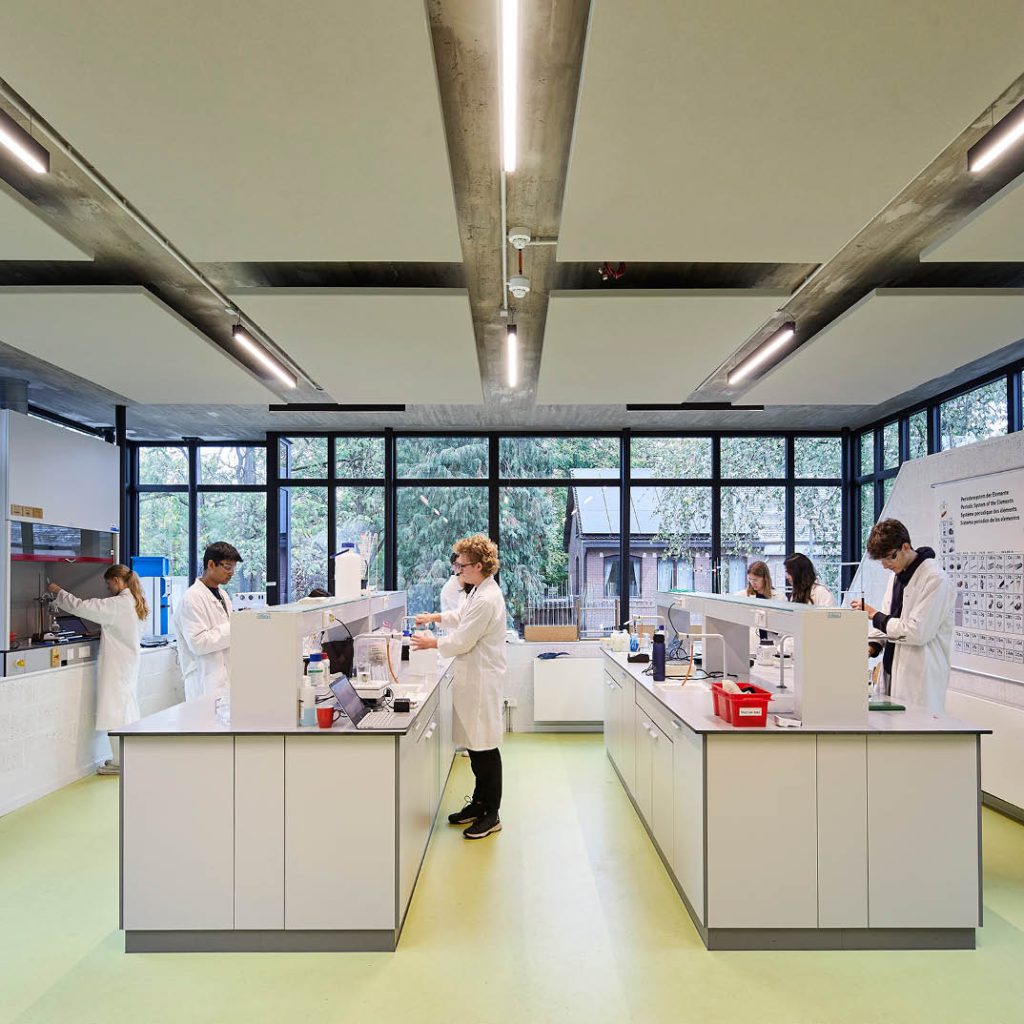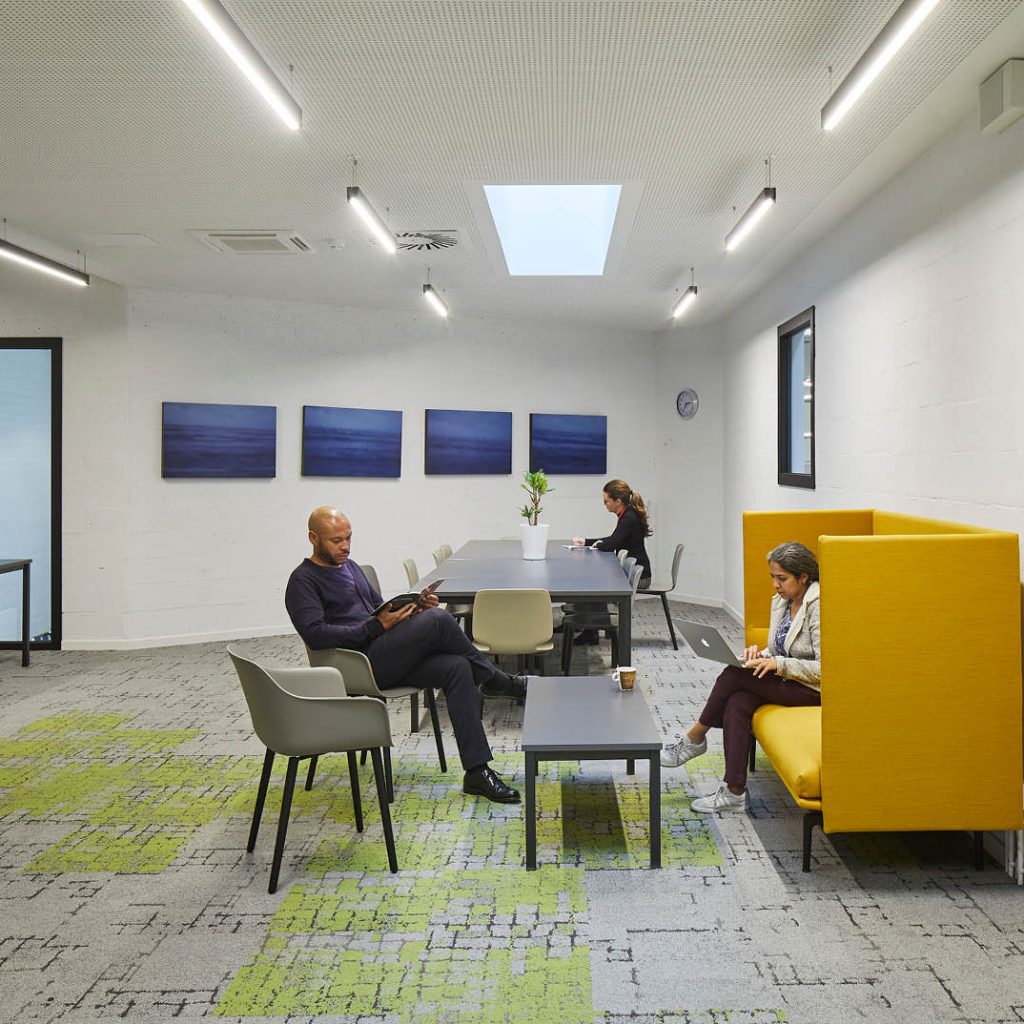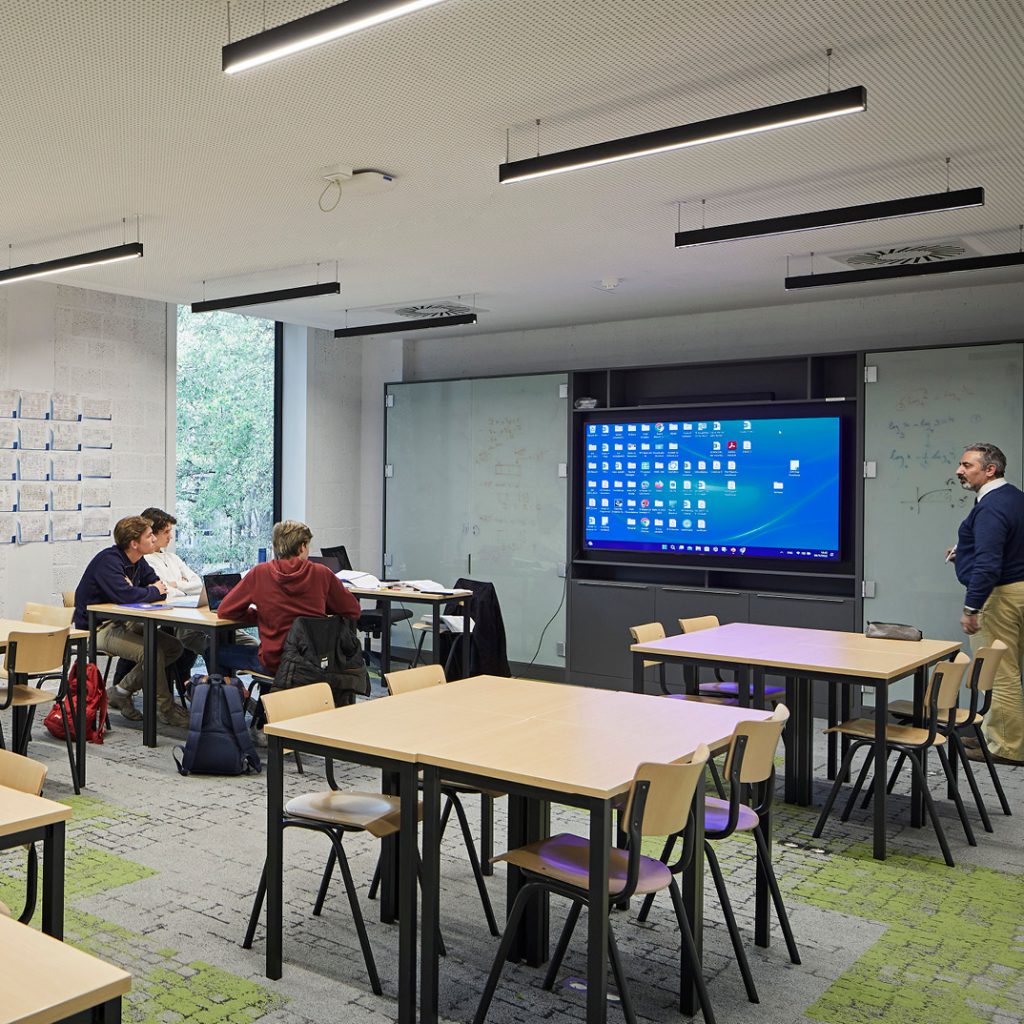Project Details
Project Name: Antwerp International School
Architect/Designer: tp bennett
Photographer: Hufton+Crow
Products: Rubber noraplan® valua & noraplan® sentica. Carpet Tile Kerbstone, Moss & Moss in Stone
As the Antwerp International School (AIS) settled back into in-person learning following the pandemic, it did so with a new vision for a STEM-focused institution that gives students the power to choose how they learn best. This would require a learning environment like no other.
AIS contracted architectural, design and planning practice, tp bennett, to transform one of its buildings into a STEMzone. With a focus on a holistic approach to education, the new space features a flexible collaboration zone, fabrication lab, materials workshop, and laid-back social areas.
In the previous set-up, space went underutilised and disciplines existed separately in inflexible classrooms, which complicated wayfinding and made it difficult to inspire creative thinking and connection among students. To ensure the design of the new STEMzone delivered on the ambition for a dynamic learning environment, tp bennett turned to Interface to supply a suite of inspiring, sustainable and durable flooring solutions.
Design That Educates
AIS’s vision was an environment where students could experiment and reflect. For the fabrication and materials labs, tp bennett chose Interface’s noraplan valua and noraplan sentica rubber sheet flooring collections for a robust slip-and fire-resistant solution. Andy Mathews, Account Manager at Interface explained: “The rubber floor covering is designed for heavy use, in this case to allow students to get hands on in practical science and technology lessons. Acoustics was another key consideration on this project, and noraplan’s high footfall sound absorption is perfect for keeping classes from disturbing one another.” noraplan valua also features in the robotics unit as the noraplan flooring will withstand the trials of robots built by students without scratching, allowing them to fully immerse themselves in the whole process of scientific development.
Jane Crowhurst, director at tp bennett, said: “The labs and workshops were designed as spaces that further the process of inquiry, experimentation and reflection that goes into learning. In practice, that means building them to last, and the noraplan flooring from Interface will ensure that they stay intact and looking great. We saw for ourselves during the build how easy it is to clean and maintain – and the school is feeling the benefit of that too now in practice.”
Design That Inspires
The STEMzone wasn’t just about giving students space to test their ideas. The brief given to tp bennett was to design a space that was as beautiful as it was functional, and which inspired and engaged students to embrace their own creativity and tell their own stories.
As a result, soft furniture with high-quality fabrics was chosen for social and informal teaching areas to give students the opportunity to take time away from learning spaces to reflect. “The luxurious design chosen for breakout areas is a deliberate departure from the functional and robust design employed elsewhere in the space – students can’t be expected to create beautiful or innovative work if the message sent by their environment is that they can’t be trusted to look after beautiful spaces,” said Jane.
Elements of biophilia throughout the design encourage students to reflect on the natural environment for beauty and inspiration. Interface’s Human Connections carpet tile collection was chosen for social and collaboration areas, in the Kerbstone, Moss, and Moss in Stone textures, all of which are inspired by the boundaries between the natural and human-made worlds.
Jane said: “The Interface carpet is one of the design choices that’s attracted the most attention and the most admiration from students, teachers and the project team. The wellbeing-boosting and calming effects of biophilia are well known, but the mix of the stone and moss, and the natural transition between the two, will help students situate themselves and their work within the larger natural world.”
Design That Empowers
A driving force behind the new design was giving students the power to choose how they learn best. Jane added: “Providing a variety of learning and social environments will help pupils manage the ebb and flow of the school day, but is vital for neurodiverse students who, without the right space, could struggle to learn effectively.”
Areas in the new design are coded according to a scale, from very low stimulation, including library and focus areas, to very high stimulation, such as the event and showcase spaces. This level of flexibility enables staff and students to pick the level that’s right for them or their class – a transformation from the previous space, where subjects were separated from one another by solid, opaque walls, and where one subject began only where another ended.
To minimise the environmental impact of the project, tp bennett established a clear hierarchy of waste that made sure every possible option was explored before anything was disposed of. This commitment carried through to the specification of Interface flooring – all of the company’s flooring products are carbon neutral across their entire lifecycle. Additionally, when they’re no longer needed at AIS, the products can be taken back through the company’s ReEntry programme, diverting them from landfill.
The Right Impact
The way staff and students at AIS teach and learn in STEM subjects has been transformed. The new design equips them with what they need, but also unlocks new methods of teaching and learning that will prepare students better for life beyond AIS.
Andy Mathews, National Account Manager at Interface, said: “This was an incredible project to be involved in. It sets a new standard for education spaces and demonstrates what we can achieve when we really design with purpose. It’s exciting that Interface flooring is contributing to shaping the learning experience at AIS.”
Andreas Koini, Head of School at Antwerp International School, added: “The STEMzone is a perfect representation of the future of education, and we’re seeing the benefits already as students and teachers embrace this new way of learning. Now that we’re here, it’s hard to imagine any other way.”
For more information about Interface, visit www.interface.com.



